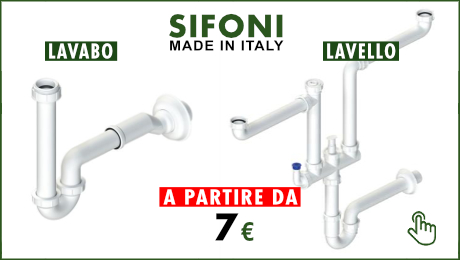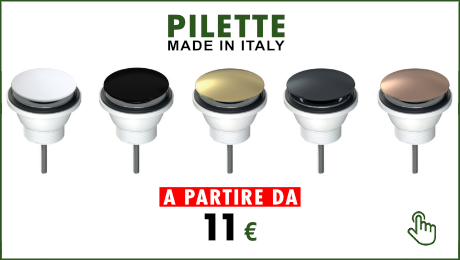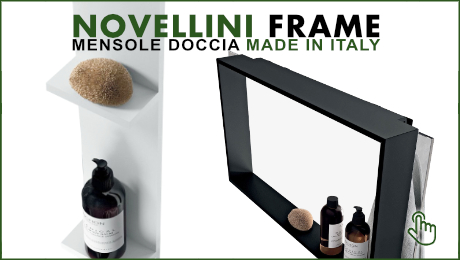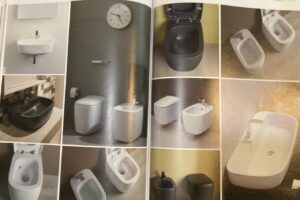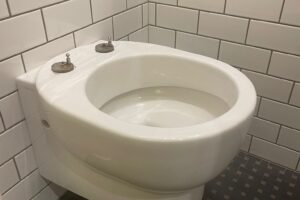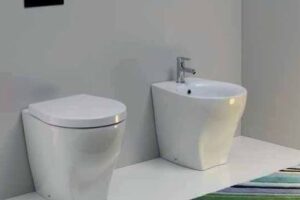If you are going to buy a toilet seat on the site Sintesibagno.shop, you will have realised that for the same sanitary ware there are usually several proposals in terms of shape and above all material. Toilet seats have always been produced with a wooden core and then painted or cast (we will explain the difference between these two processes later) in various colours besides white. With the emergence of plastics from the late 80s, this type of product also began to be made in thermoset and thus the first WC seats with wraparound covers were born (in practice the cover when closed hides the donut, hence the name) and more recently the SLIM models (very thin and robust products).
Wooden toilet seats cast in polyester resin
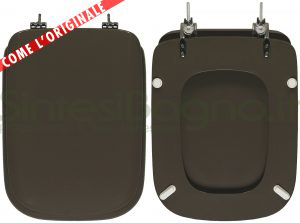
Let’s start talking about coated wooden toilet seats, and in particular those commonly called CASTED. They are the top of the range in this category. They are an expression of the most classic Made in Italy craftsmanship. This type of toilet seat is made using a solid chipboard core, covered with a 2/3 mm thick layer (depending on the manufacturer) of hand-poured polyester resin. Although this product is an industrial product, it requires a lot of human dexterity in production (needing shaping, casting, sanding and polishing), but the end result is an excellent product! These toilet seat covers are therefore made by ‘casting’ polyester resin around a chipboard core. It is precisely the thickness that envelops the wooden part that characterises its robustness and solidity over time. The result is a high-quality, durable product with a high-gloss, shiny surface that can be made in any colour shade of ceramic. The hinges combined with these products are always made of metal, chrome-plated brass or even stainless steel.
Until about 10 years ago, all ceramic manufacturers offered matching toilet seats of this type and material, so with these toilet seats, all kinds of shapes could be produced that were perfectly suited to the toilet in question. Most ORIGINAL models were and are reproduced in this way. Almost all products in the Sintesibagno.shop listed AS THE ORIGINAL are made of polyester cast wood, here is an example with the model CONCA by Ideal Standard.
Lacquered MDF toilet seat cover (painted)
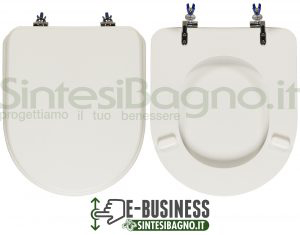
What is MDF? It is a wood derivative, which is made from a mix of resins and virgin wood fibres. The clearer the quality, the more durable the toilet seat cover will be. This material is the core of the product, which will be finished with several layers of varnish to produce a robust item that retains its original colouring for a long time. It is the typical economical alternative to polyester castings. The qualitative difference in this type of product lies in the several layers of paint that are applied to produce it and the quality of the paints used, as well as the hinges, which may be made of quality chrome-plated brass or less valuable metal alloys. A product of this type, if made by capable companies (and in Italy we have more than one), and treated and maintained correctly (see in this regard CLEANING and MAINTENANCE of TOILET SEAT) can last for years. In the Sintesibagno store, models of this type are labelled E-business and have an average price of 30/40 Euro. In the image opposite you can see the model in this material from the series Esedra by Ideal Standard.
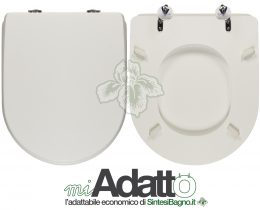
The discriminating factor that makes the finished price on a product of this type, in addition to the quality of the hinges, are the layers of varnish (lacquer) that are applied. The more layers are applied, the higher the quality of the product and consequently the production cost will affect the final price. This is why for the same model of toilet seat you can have such different prices, starting from about 50 Euro of the polyester cast, to the 30/40 of the E-business product to those in the first price bracket that cost only € 20 that in the store you will find catalogued as MiADATTO category. The lacquered toilet seat of this category always for the Esedra Ideal Standard toilet seat can be found in the store at the following link [ clik here ]
Thermoset toilet seat (UREA – urea resin)

What is UREA? It is a material derived from the purest cellulose, it is totally aseptic and cannot be attacked by the most common pathogens. It is water-repellent, resists dirt stains, burns, scratches, is non-porous and guarantees smooth, high-gloss surfaces. You can see why it has become the most widely used raw material to produce toilet seat covers. What’s more, it allows the possibility of creating wrap-around and curved shapes. Hence the first thermoset WC covers with wrap-around lids, which began to make a name for themselves in the world of sanitary ware in the late 90s. In the image to the side you can see the version for the ESEDRA toilet bowl by Ideal Standard, which you will then find on the site at the following link [ clik here ]
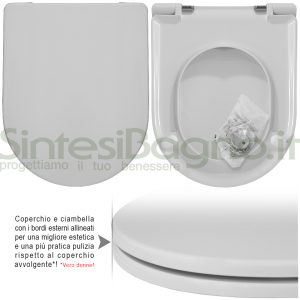
All these features of the thermoset WC covers with wrap-around lid have allowed them to become very popular, but over time a small criticism has been raised by the many customers who have installed them in their bathrooms: the many curves of the shape, both of the lid and especially of the rim, sometimes made the process of maintaining cleanliness difficult. The toilet seat manufacturers, always ready to intercept the tastes and desires of their customers, developed a new type of toilet seat which is now identified with the name SLIM (in the Sintesibagno catalogue you can find them with the term PLUS) In the photo to the side you can see the version always for the Esedra toilet by Ideal Standard (Here the LINK to the store), as you will notice the wrap-around lid has disappeared, visually it is the same as the wooden models (cast and lacquered). Lid and donut are again aligned ( even if thinner) but the material is still thermoset with all its merits. One can speak of a nice change in both form and substance. On the thermoset models, stainless steel hinges, which are very robust and durable; provided that… (see CLEANING and MAINTENANCE of TOILET SEAT).





